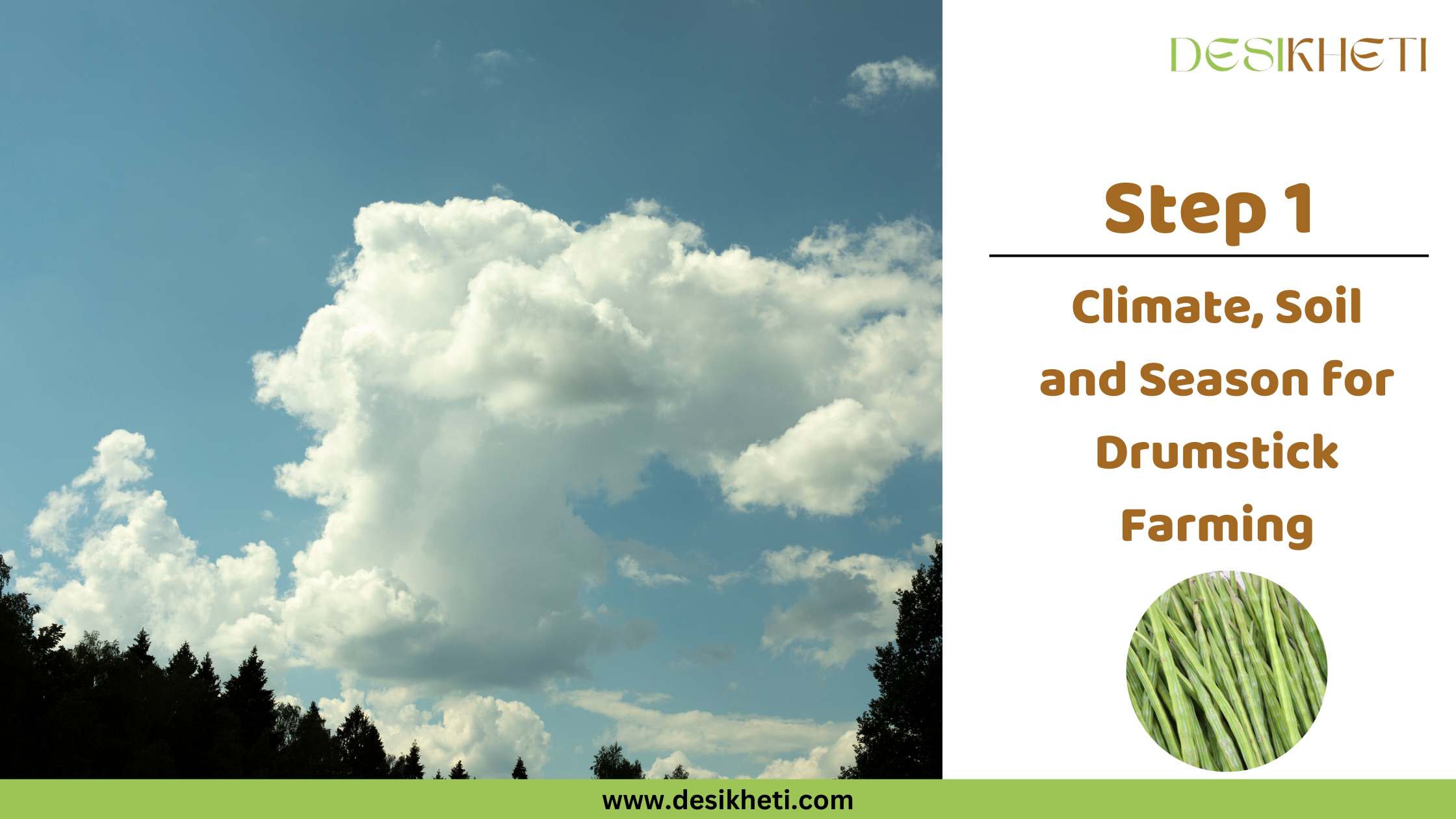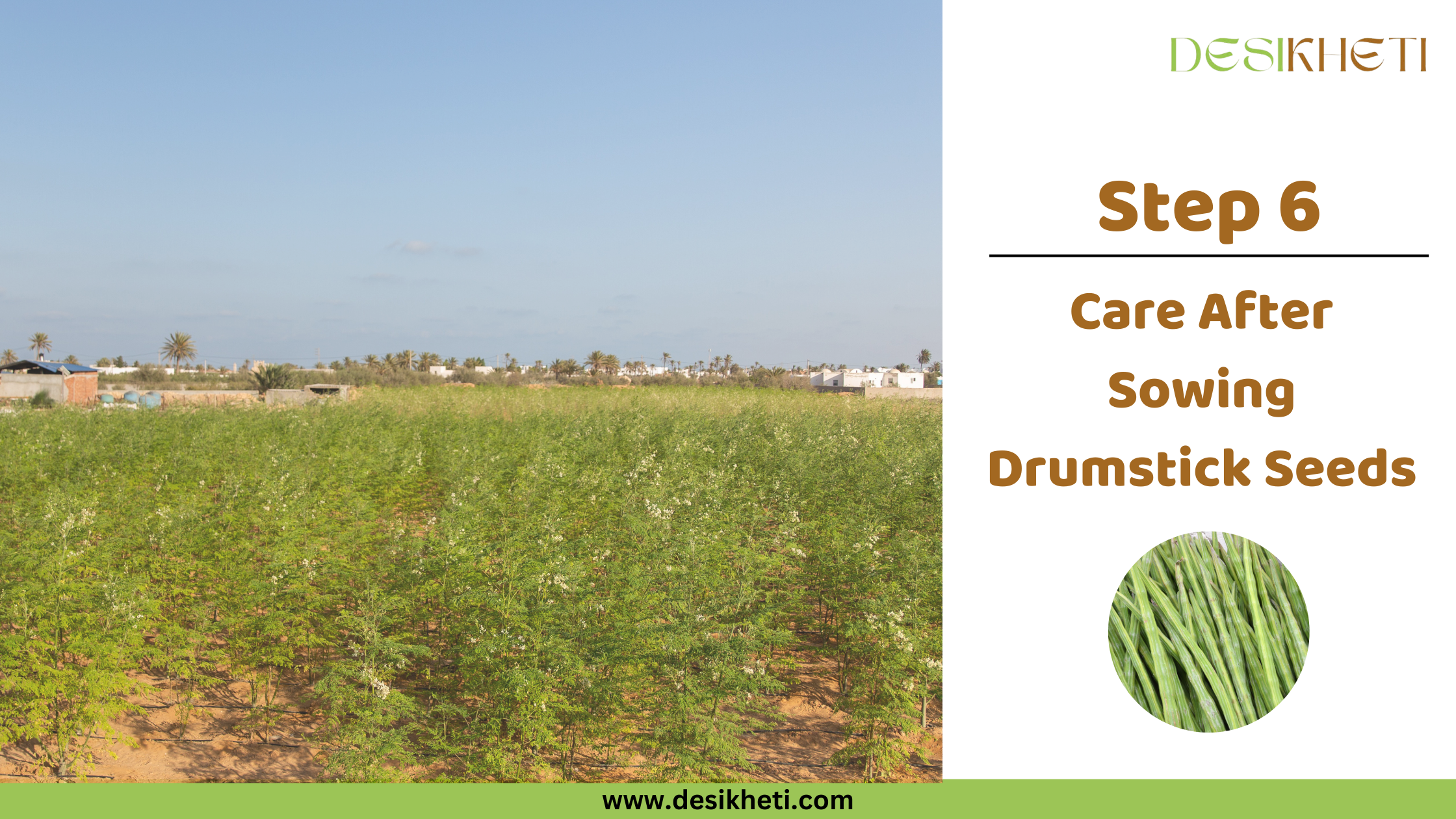Table of Contents
Introduction
Drumstick (Moringa oleifera), commonly known as moringa, is gaining popularity across the globe thanks to its impressive nutritional and medicinal benefits. Often referred to as the “miracle tree,” drumstick is rich in vitamins, minerals, and antioxidants, making it a valuable addition to daily diets. Its tender pods, leaves, and even seeds are widely used in both traditional and modern cuisines.
With growing demand in local and international markets, drumstick farming is emerging as a profitable venture for many farmers. It is easy to cultivate, drought-resistant, and adaptable to a variety of climates, especially thriving in dry and semi-arid regions.
Thinking of starting your own drumstick farm? You’re in the right place! In this blog, we’ll guide you through how to sow drumstick seeds in 7 simple steps.

Step 1: Climate, Soil, and Season for Sowing Drumstick Seeds

Climate for Drumstick Cultivation
Drumstick grows well in tropical regions and performs well under dry and arid conditions. It is a drought-resistant crop, with optimal growth occurring at temperatures between 25°C and 35°C. However, temperatures above 40°C may lead to excessive flower shedding. The crop is highly susceptible to frost, which can damage both its growth and yield.
Soil for Drumstick Cultivation
Drumstick can grow in a wide range of soils, but sandy loam soil rich in organic matter is ideal. Heavy clay soils are not suitable, as drumstick plants are sensitive to waterlogging. A well-drained soil with a pH range of 6.0 to 7.0 is considered optimal for healthy growth.
Season for Drumstick Cultivation
Generally, moringa seeds are sown during the Kharif season, from June to October. In some regions, it is also cultivated during the Rabi season, depending on local climatic conditions.
Step 2: Selecting the Right Drumstick Variety

Drumstick (Moringa) is available in both perennial and annual types. While selecting a variety, factors such as the purpose of cultivation, local preferences, and climatic conditions should be considered. For your convenience, a few popular drumstick varieties are listed below.
Step 3: Procuring Quality Drumstick Seeds

For successful drumstick farming, selecting high-quality seeds is essential. Even with the best cultivation practices, poor-quality seeds can result in low yields and weak plant health. Looking for the best drumstick seeds? DesiKheti offers a wide range of premium drumstick seeds tailored to your farming needs. Browse our collection, place your order online, and enjoy fast, reliable delivery right to your doorstep.
Step 4: Land Preparation for Sowing Drumstick Seeds

Clear all debris from the previous crop. Plough the land two to three times to ensure proper soil aeration. During the final ploughing, incorporate 25 tonnes of farmyard manure (FYM) per hectare into the soil. Pits may also be dug, depending on the method of sowing.

Step 5: Sowing Drumstick Seeds

Drumstick can be propagated either by sowing seeds or planting limb cuttings. Perennial types are commonly propagated through limb cuttings, while annual types are grown from seeds. Perennial varieties are generally preferred for kitchen gardens, whereas annual varieties are more suitable for farming purposes. Since this blog focuses on drumstick seed sowing for farming, we will cover the seed-based propagation method.
Seed Rate: Approximately 200 grams of moringa seeds are required per acre. However, the exact seed rate may vary depending on spacing, method of sowing, and other factors.
Seed Treatment: Drumstick seeds sold by private companies are usually pre-treated with chemicals. If the seeds are untreated, they can be treated with fungicides such as Thiram or Captan.
Seeds can either be sown directly in the field or first raised in a nursery and then transplanted. Sowing can be done in rows, pits, or trenches at a depth of 2.5 to 3 cm.
For nursery raising, use poly bags filled with a mixture of soil and organic compost in a 3:1 ratio. Sow two seeds per bag. The seedlings are ready for transplanting after 30 to 40 days, once they reach a height of about 30 cm. It’s advisable to raise an additional 75 to 100 seedlings in polybags for gap filling in the main field.
Step 6: Care After Sowing Drumstick Seeds

Training and Pruning:
When the seedlings reach a height of 75 to 100 cm, they can be headed back. This practice encourages the production of side shoots and allows strong side shoots to grow in all directions. Once these side shoots reach about 45 cm in length, they can also be headed back. This helps develop a well-structured plant framework and significantly increases yield.
Water Management:
Proper irrigation management is crucial for healthy drumstick growth. The first irrigation can be done before sowing, followed by another on the third day after sowing. Subsequent irrigations can be scheduled at intervals of 7 to 10 days, depending on the season, soil moisture content, and weather conditions. Flowering and fruit formation are critical stages where adequate water is essential. However, ensure there is no waterlogging, as drumstick plants are sensitive to it.
Weeding Management:
The first weeding can be done when moringa plants are 2 to 3 weeks old. Subsequent weddings may be done once every 30 days, depending on weed growth and field conditions.
Step 7: Harvesting Drumstick

Drumstick harvesting depends on the variety grown. Annual types are ready for harvest within 6 to 8 months of sowing, while perennial varieties propagated from seeds may take around 3 years to produce their first harvest. The pods are typically harvested about 60 days after flowering, once they reach optimum edible maturity. Generally, pods measuring around 15 to 20 cm in length are ideal for harvesting.

Common FAQs Related to Drumstick Seed Sowing
Q. What climate is best for growing drumsticks?
A. Drumstick grows well in tropical regions with temperatures between 25°C and 35°C. It thrives in dry, arid conditions and is highly drought-resistant.
Q. Which soil is best for growing drumsticks?
A. Well-drained sandy loam soil rich in organic matter is ideal for drumstick cultivation.
Q. What is the seed rate of drumsticks per acre?
A. On average, around 200 grams of drumstick (Moringa) seeds are required per acre. However, the exact seed rate may vary based on the spacing and method of sowing.
Q. When can drumsticks be harvested?
A. Annual drumstick varieties are ready for harvest within 6 to 8 months of sowing. The pods can typically be harvested around 60 days after flowering when they reach a length of 15 to 20 cm.
Q. How deep can drumstick seeds be sown?
A. Drumstick seeds can be sown at a depth of 2.5 to 3 cm.
Q. What is the scientific name of drumstick?
A. The scientific name of drumstick is Moringa oleifera.

Join DesiKheti Whatsapp Channel for regular updates, farming tips, and information on agriculture.
